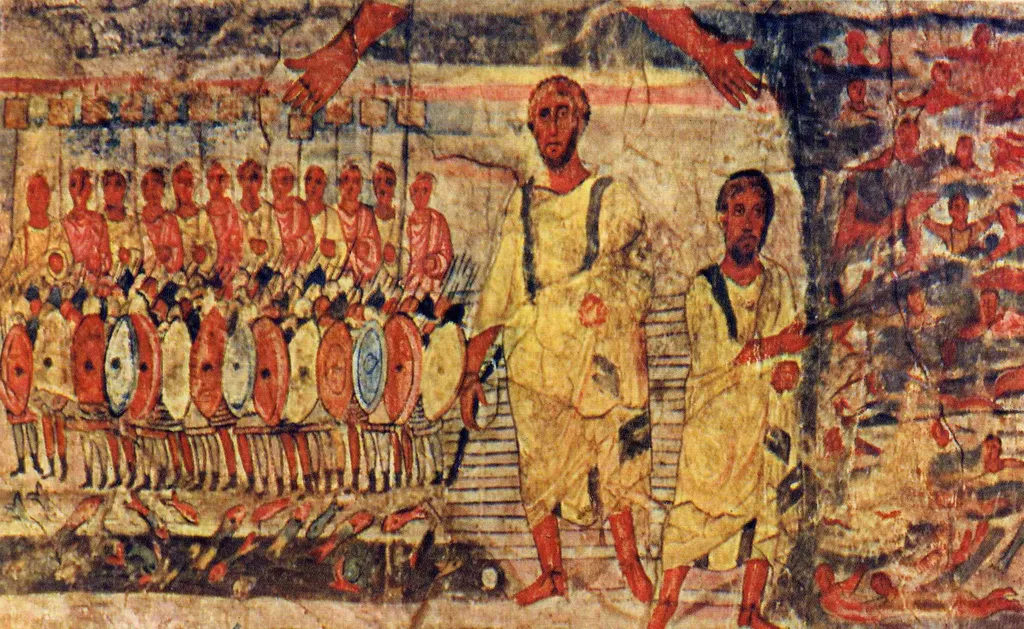Judaism, one of the world’s oldest monotheistic religions, has its roots in the ancient Middle East. But who were the first Jews? This question remains a topic of much historical and religious debate. In this article, we’ll explore the fascinating history of Judaism, its early beginnings, and the influential biblical figures that helped shape its identity. Join us as we delve deeper into this intriguing subject and uncover the mysteries of Judaism’s origins.
Ancient Israelites and the Hebrew Religion

The origins of Judaism can be traced back to the Ancient Israelites and their belief in the Hebrew religion. The Israelites were a nomadic tribe that migrated from the Fertile Crescent, settling in the land of Canaan, which is now Israel, around 1200 BCE.
The foundation of the Hebrew religion was based on the idea that there was only one God, Yahweh, and that he had chosen the Israelites as his chosen people. The Hebrew Bible, also known as the Tanakh, documents the history and beliefs of the Ancient Israelites and the early development of Judaism.

Here are some key events and figures that contributed to the rise of Jewish identity:
-
Abraham and Sarah: According to the Bible, God made a covenant with Abraham, promising him that he would be the father of many nations. This covenant is seen as the beginning of God’s relationship with the Israelites.
-
Isaac and Rebekah: Isaac was the son of Abraham and Sarah and the father of Jacob and Esau. Isaac’s story is significant because he was almost sacrificed by his father as a test of faith.
-
Jacob and Esau: Jacob was the younger twin brother of Esau, who was born holding onto his brother’s heel. Later on, Jacob tricked his father into giving him Esau’s birthright and blessing. He eventually became the father of the twelve tribes of Israel.
-
Moses and the Exodus: According to the Bible, Moses was chosen by God to lead the Israelites out of slavery in Egypt and received the Ten Commandments from God on Mount Sinai.
-
King David, Jerusalem, and the Temple: King David established Jerusalem as the capital of Israel and his son, King Solomon, built the first temple in Jerusalem. The temple served as the center of Jewish worship until its destruction by the Babylonians in 586 BCE.
As the Israelites developed their culture and religion, they faced challenges and experienced periods of exile. However, their faith and traditions were preserved and adapted through the development of Rabbinic Judaism, which emerged after the destruction of the Second Temple in 70 CE.
In conclusion, the Ancient Israelites and their belief in the Hebrew religion played an integral role in the development of Jewish identity and the foundation of Judaism. Their history and heritage continue to shape Jewish customs and practices today.
Biblical Figures and the Rise of Jewish Identity
As the ancient Israelites continued to evolve, so did their religious beliefs, and it was during this time that the concept of Jewish identity first began to emerge. The Bible mentions several key figures who played significant roles in shaping the Jewish culture we are familiar with today.
Abraham and Sarah were among the first and most revered biblical figures of the Hebrew Bible. They were the parents of Isaac, and by extension, Ishmael, and were known for their unwavering faith in God. Abraham is said to have been the first person to teach monotheism, the belief in one God, which formed the foundation of Judaism.
Isaac and Rebekah, his wife, were the next in line. Isaac was the son of Abraham, and through him, the family line continued. The story of Isaac’s near-sacrifice at the hands of his father is one of the most well-known tales in the Hebrew Bible. Rebekah was a woman of strong character, and her devotion to God and her family made her an inspiration to generations of women.
Jacob, the son of Isaac, and his twin brother Esau were born into conflict. Jacob was known for his cunning and deception, while Esau was favored by their father. Their tale is a complex one, but out of it emerged the twelve tribes of Israel, which were said to be the direct ancestors of the Jewish people.
Moses, of course, is one of the most important figures in Jewish history. He was born into slavery in Egypt but was saved by his mother and raised as an Egyptian prince. He eventually became the leader of the Israelites and, with God’s help, led them out of slavery and into the promised land. Moses is revered for his wisdom, insight, and devotion to God.
King David is another key biblical figure who played a significant role in shaping Jewish culture. He was the first king of Israel and was known for his courage, loyalty, and devotion to God. He established Jerusalem as the capital city and built the first temple, an act that would define Jewish identity for centuries to come.

The rise of Jewish identity was not without struggle, however. The Jewish people were exiled from their homeland several times and were subjected to persecution and discrimination throughout their history. Nevertheless, they persevered, and their traditions and customs continue to hold great significance for people all over the world.
In conclusion, the biblical figures who shaped Jewish identity are a testament to the power of faith, devotion, and resilience. They continue to inspire people of all ages and backgrounds, and their legacy lives on in the Jewish community today.
Establishment of the Jewish Civilization
The establishment of the Jewish civilization is an interesting topic that helps unravel the origins of Judaism. Here are some key points:
- The establishment of the Jewish civilization can be traced back to the reign of King David in the 10th century BCE.
- David established Jerusalem as the capital of Israel and built a great temple, which became the center of Jewish religious life.
- David’s son, Solomon, inherited the throne and continued the building of the temple. Under his rule, Israel became a prosperous and powerful nation.
- However, after the death of Solomon, the kingdom split into two: Israel in the north and Judah in the south.
- Despite the political division, Jewish culture and religion continued to flourish in both kingdoms.
- In 586 BCE, the Babylonians invaded Judah and destroyed the temple in Jerusalem. This event is known as the Babylonian Exile and it marked a turning point in Jewish history.
- During the Exile, many Jews were forced to leave their homeland and settle in Babylon. This sparked a period of cultural and religious renewal as the Jews re-evaluated their identity and traditions.
- In 539 BCE, the Persian king Cyrus the Great conquered Babylon and allowed the Jews to return to Jerusalem and rebuild their temple.
- The Second Temple was completed in 516 BCE and became the focal point of Jewish religious life for the next 500 years.
Overall, the establishment of the Jewish civilization was a gradual process that was marked by periods of growth and decline. Despite facing persecution and prejudice throughout history, the Jewish people have maintained their identity and traditions for thousands of years.
Moses and the Exodus from Egypt
During the time of the Pharaohs, the Israelites were oppressed and enslaved in Egypt. The story of Moses and the Exodus tells how Moses was chosen by God to lead his people out of Egypt and towards their promised land. It is one of the most significant events in Jewish history and is celebrated through the Passover holiday.
According to the Bible, God spoke to Moses through a burning bush and commanded him to return to Egypt to bring the Israelites out of slavery. Moses and his brother Aaron confronted the Pharaoh, demanding freedom for God’s people. But the Pharaoh remained defiant and, as a result, Egypt experienced ten plagues that devastated the land.
« Unveiling the Story of Hadassah: A Heroine of Jewish Heritage
Unveiling the Identity of the Prince in Ezekiel 46: A Biblical Study »
The final plague saw God strike down the firstborn of every household in Egypt. However, God told the Israelites to mark their doors with the blood of a lamb so that the angel of death would pass over their homes. This led to the Passover feast that is still celebrated today.
Following the final plague, Pharaoh agreed to release the Israelites, but soon changed his mind and chased them. With God’s help, Moses parted the Red Sea, allowing the Israelites to pass through safely. However, Pharaoh’s army was destroyed when the waters returned to their original position.
The account of Moses and the Exodus is a significant event in Jewish history, representing the triumph of God’s justice and mercy over tyranny. It believed to have taken place around 1446 B.C. and serves as a powerful reminder of the great lengths God will go to rescue His people from oppression.
The freedom that the Israelites gained through the Exodus is still celebrated today and forms a crucial part of Jewish identity. It also serves as a central theme for many Jewish customs and traditions, such as the Passover Seder and the blowing of the shofar during Rosh Hashanah.

As Christians, we can learn much from the story of Moses and the Exodus. It reminds us of God’s sovereignty and His faithfulness to those who put their trust in Him. It also encourages us to stand against injustice and to fight for the oppressed, just as Moses did for his people.
In conclusion, the story of Moses and the Exodus is a central component of Jewish identity. It teaches us about the faithfulness of God, the importance of freedom, and the power of standing against injustice. As Christians, we can learn much from this story and celebrate it along with our Jewish brothers and sisters.
King David, Jerusalem, and the Temple
King David is often remembered as one of the greatest figures in Jewish history. He was the second king of Israel and was known for his military prowess and strategic leadership. David was also a passionate musician and poet who authored many of the psalms found in the Hebrew Bible.
Under David’s leadership, Jerusalem emerged as the political and religious center of the Jewish people. He conquered the city from the Jebusites and established it as the capital of Israel. David also had a vision of building a grand temple for God to replace the tabernacle, a portable sanctuary used by the Israelites since the time of Moses.

While David made preparations for the temple, it was his son Solomon who ultimately oversaw its construction. The temple was a magnificent structure made of gold, bronze, and cedar wood, with multiple courtyards and a large sanctuary. It was a symbol of the Jewish people’s devotion to God and the center of their spiritual life.
The temple played a crucial role in Jewish worship and sacrificial practices. It was believed that God’s presence dwelled within the temple, and only the high priest could enter the innermost sanctuary once a year on the Day of Atonement. The temple also served as a gathering place for the Jewish people during festivals and holidays.
Unfortunately, the temple was destroyed by the Babylonians in 586 BCE, and again by the Romans in 70 CE. The loss of the temple had a profound impact on the Jewish community. It forced them to adapt and develop new traditions and practices, leading to the development of Rabbinic Judaism.
In summary, King David’s legacy as a great leader and musician contributed to the establishment of Jerusalem as the capital of Israel and the building of the first temple. The temple played a significant role in Jewish worship and served as a symbol of the Jewish people’s relationship with God. Its destruction led to a significant shift in Jewish culture and practice, illustrating the resilience of the Jewish people over time.
Here are the main points:
- King David was a great leader and musician.
- He established Jerusalem as the capital of Israel.
- David had a vision for building the temple, which was completed under his son Solomon.
- The temple served as the center of Jewish worship and sacrifice.
- The temple’s destruction led to the development of Rabbinic Judaism.
Jewish Diaspora and the Development of Rabbinic Judaism

After the Roman destruction of the Second Temple in Jerusalem in 70 CE, the Jewish people were scattered throughout the Mediterranean region and beyond, marking the beginning of the Jewish Diaspora. This dispersion forced the Jewish people to adapt their practices and traditions to the new regions in which they settled, leading to the development of Rabbinic Judaism.
Rabbinic Judaism was born out of a need to preserve Jewish identity and customs while living under foreign rule. It was developed by Jewish sages, known as Rabbis, who provided interpretations and insights into the Jewish scriptures. The central text of Rabbinic Judaism is the Talmud, which is a compilation of Jewish law, lore, and commentary on the Hebrew Bible.
The Talmudic scholarship of the Rabbis provided a framework for Jewish identity and allowed for the continuation of Jewish traditions in the face of foreign suppression. It was an evolution of Jewish culture and practice that shaped the Judaism of today.
As the Jewish people continued to migrate, Rabbinic Judaism spread throughout the Mediterranean region, North Africa, and Europe. It became the dominant strand of Judaism following the destruction of the Second Temple and has continued to adapt to the ever-changing global landscape.
Today, Rabbinic Judaism is a diverse and dynamic religion that has had a profound impact on the world. Its scholars and leaders have shaped Jewish mysticism, provided a foundation for Jewish scholarship, and helped to preserve Jewish genealogy and heritage.

Despite the challenges and hardships faced by the Jewish people, the development of Rabbinic Judaism has allowed for the continuation of Jewish traditions and customs, enabling Jewish people to maintain their unique identity and cultural heritage.
The Jewish Diaspora and the development of Rabbinic Judaism have played a significant role in shaping the history of the Jewish people and the world at large. It continues to inspire and educate people about the rich cultural and religious heritage of the Jewish people.


















